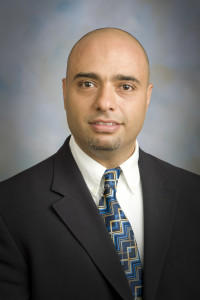Hussam Mahmoud, assistant professor in the CSU Department of Civil and Environmental Engineering, is among 89 young engineers selected to take part in the National Academy of Engineering’s 21st annual U.S. Frontiers of Engineering (USFOE) symposium in September. Engineers ages 30 to 45 who are performing exceptional research and technical work in a variety of disciplines were nominated by fellow engineers or organizations to participate in the event.
The 2015 USFOE will cover cutting-edge developments in four areas: cybersecurity, forecasting natural disasters, optical and mechanical materials, and engineering the search for earth-like exoplanets.

Mahmoud’s research covers both structural engineering and biomedical engineering; he is the director of the Structural Laboratory at CSU and also serves on the faculty of the School of Biomedical Engineering.
In his structural engineering research, Mahmoud uses his expertise in the field of materials fatigue and fracture and extreme hazards to focus on assessment of deteriorated infrastructure, especially those structures that could cause catastrophic damage should they fail, such as bridges or dams.
Average age of dams
In 2013, the American Society of Civil Engineers found the average age of the 84,000 dams in the U.S. was 52 years. ASCE estimated that more than 4,000 dams had deteriorated to a rating of “deficient,” and of those 2,000 are in high-hazard areas, protecting large populations and major developments.
And there are so many natural and manmade hazards that could cause catastrophic failure: earthquakes, hurricanes, tsunamis, fire, and explosions or the combination of any or all of the above. Structures that have been allowed to deteriorate, whether through normal wear and tear or through service in extreme environments, are more vulnerable to failure.
Mahmoud’s goal is to develop both resilient and sustainable structural systems and effective retrofit methods that can be used to mitigate the effects of harsh environments on the nation’s aging infrastructure.
He is developing new fatigue models for the evaluation of structural components and systems subjected to high strain. These new models can be used to design structures that will be more resilient to stress over a longer period of time.
A water-filled tank in the Structural Lab on the Foothills Campus helps the team simulate the stresses on steel structures from both routine service and extreme loadings. Scale models of underwater miter gates, like those at the base of locks or dams that control water flow, open and close automatically more than half a million times a month to simulate 30 years of use. The actual gates in a standard riverbed can be 60 to 110 feet tall, and can become clogged with tons of sediment or damaged by floating debris.
Inspections
“These gates have to work in harsh, corrosive environments, and the only inspection most receive is visual, once every 10 years,” Mahmoud explained. “Over many years in service, not only can the panels develop cracks, but the steel itself can become heavily corroded and experience fatigue that can lead to failure even without visible cracks on the surface.”
Mahmoud’s research is exploring materials, such as carbon fiber composites, that could be used in place of steel for use in harsh environments. He is also looking at whether such composites could be used to repair cracks in steel once they are detected.
“Whatever repair methods we use need to keep the crack from growing, or at least let it grow slowly, in a stable manner,” he said. “And we have to be able to make repairs quickly.”
In the lab, Mahmoud’s team has been repairing steel cracks with a composite material, then filming the interaction between the materials while the model miter gate is operating. According to Mahmoud, such retrofitted panels have never been tested underwater before.
Mahmoud’s studies have also added several new dimensions to existing stress testing methods, accounting for both axial tension and shear cycles; previous fracture models look at only axial tension loading. He has also added high temperatures to the possible stress factors evaluated.
In addition to being part of 2015 USFOE, Mahmoud is presenting on fatigue and fracture research to a professional conference later this month.